UPDATE (Mar 7. 2023) : We have changed our thinking/approach on this method. While Brand Swapping is still a great way to quickly identify additional keywords to write for (and shortens the overall time required to research/write) we believe it is worth rewriting the content entirely, so that it is unique (instead of re-using content, word-for-word). While we don’t have any hard evidence to suggest Google actively penalizes this approach specifically, we do know Google rewards unique content. We are of the mindset now that playing it safe is the appropriate course of action.
“Brand Swapping” is a phrase Keith and I coined to describe a content scaling strategy we’ve successfully implemented on each of our respective niche sites.
I can personally attribute over 150,000+ organic pageviews a month directly to the Brand Swapping method.
What is the “Brand Swapping” Method?
The concept behind the Brand Swapping method is simple: reuse about 80-90% of a brand related post you’ve already written to publish an entirely new piece of content for a different brand.
Let’s use the keyword, “Yamaha dirt bike won’t start”, as an example.
Start by writing the absolute best piece of content out there for “Yamaha dirt bike won’t start”.
Once you’ve crafted the perfect post and hit publish, create a list of all the other top dirt bike brands:
- Suzuki
- Honda
- Kawasaki
- KTM
- Bultaco
- Beta
- Husqvarna
- Sherco
Go ahead and spin up a draft post and do a “Find and Replace” on the “Yamaha dirt bike won’t start” post. Swap “Yamaha” for “Suzuki”.
Now do your research for “Suzuki dirt bike won’t start”.
What you’ll find is that 80-90% of the content you wrote for Yamaha dirt bikes not starting is applicable to Suzuki. It just so happens that there are a handful of things you should ALWAYS try when your dirt bike won’t start, regardless of the brand.
The KEY, however, is to make sure you adequately cover the 10-20% difference.
For example, maybe Suzuki dirt bikes have a unique issue where the clutch gets stuck, or perhaps there is a switch that has to be turned clockwise before you try starting it.
Make sure you cover these nuances explicitly in your Suzuki post.
Benefits of Brand Swapping
The obvious benefit for you as a content creator, is the ability to more easily scale content.
The fact that 80-90% of the content you wrote for Yamaha dirt bikes not starting is applicable to Suzuki means you can reuse old content over and over again for different brands.
Yes, you still have to do in-depth research to identify and cover the 10-20% difference between brands, but you will drastically reduce the amount of time you spend writing.
In the dirt bike example above, a single post becomes many!
Another benefit is highly relevant content for the reader. If you own a Yamaha dirt bike and it won’t start, which post are you more likely to click/want: “Dirt bike won’t start”, or “Yamaha dirt bike won’t start”?
You want the Yamaha specific content.
Yes, there will be a lot of overlap with other dirt bike brands, but the 10-20% that’s specific to Yamaha could make all the difference when it comes to getting your dirt bike started again.
A true win-win – you get more traffic, and your reader gets the answer they were looking for.
Brand Swapping case studies
Here are some case studies of various Brand Swapping clusters that are currently live on my site.
Note that the keywords are made up in my examples below, but all the data is real.
All pageview stats are from a single month: July 2022.
Example #1
This cluster represents the first time I used Brand Swapping on my niche site. I turned 1 post into 14.
These posts were all published around September of 2021. In total, this cluster brings in 70,000+ pageviews a month.
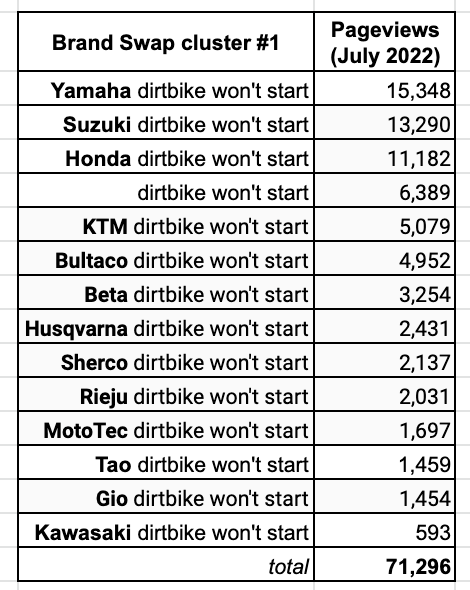
You’ll notice I even ended up writing, and ranking for the generic, brand-less keyword “dirtbike won’t start”.
Example #2
This cluster was published around October of 2021. I turned 1 post into 6. This cluster brings in 20,000+ pageviews a month.
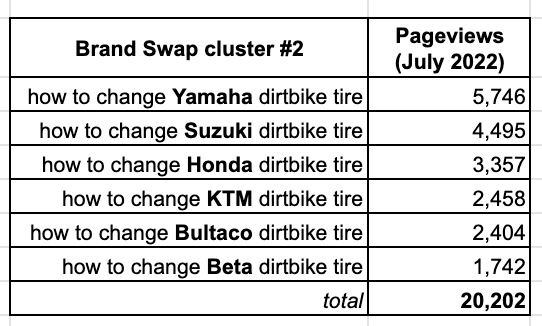
Example #3
This cluster was published around April of 2022. I turned 1 post into 13. This cluster brings in 26,000+ pageviews a month.
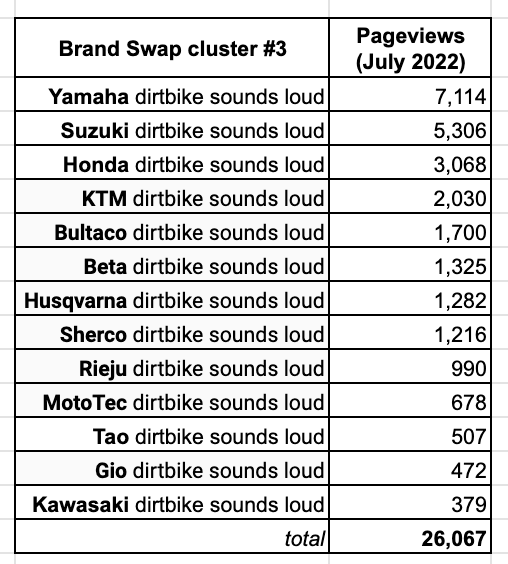
These are the primary Brand Swapping clusters on my site today, but I have about 5 others.
In total, Brand Swapping accounts for about 150,000+ out of the 700,000+ total pageviews my site receives each month.
Is Brand Swapping considered Duplicate Content?
“Duplicate content” gets thrown around quite a bit in SEO land, but I think it’s largely misunderstood.
Let’s start with Google’s own definition of duplicate content:
“Duplicate content generally refers to substantive blocks of content within or across domains that either completely match other content in the same language or are appreciably similar. Mostly, this is not deceptive in origin. Examples of non-malicious duplicate content could include:
- Discussion forums that can generate both regular and stripped-down pages targeted at mobile devices
- Items in an online store that are shown or linked to by multiple distinct URLs
- Printer-only versions of web pages.”
Usually the issue here is that Google simply doesn’t know which page it should rank, unless you take the necessary steps to indicate your preferred URL (“canonicalization“).
If you don’t take these steps, Google will choose which page to rank for you, and the other “duplicate” pages won’t be indexed at all.
That’s the main “problem” with duplicate content, the pages deemed “duplicates” simply won’t rank. But as John Mu has said previously, Google “would not demote a website because of duplicate content”.
And, in the case of Brand Swapping, why would Google penalize you? You’re creating quality, relevant content that the reader wants. That’s Google’s entire business model.
So far our sites are evidence that not only is the Brand Swapping method “allowed”, it’s rewarded.
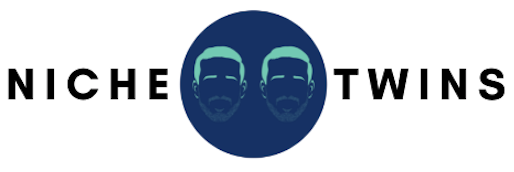
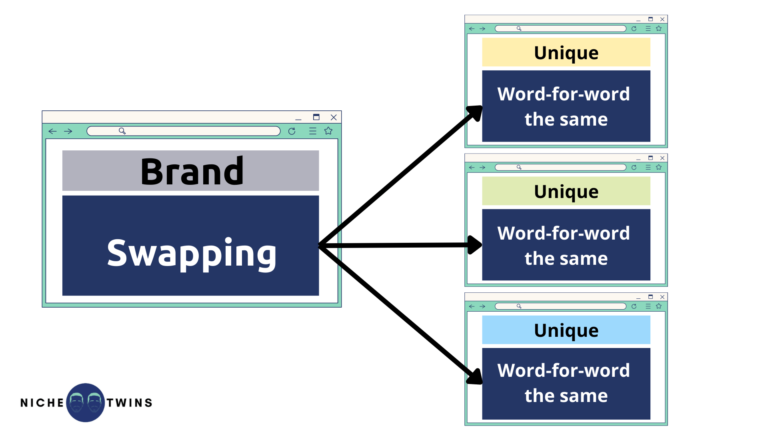

What a great time saver Mike. Great breakdown and overview. Appreciate it. This will help a lot of folks out struggling in ‘alike’ niches and markets. Thanks!
Cheers!
This is a great idea. I think this will definitely help many bloggers to craft out posts faster than they use to publish.
Thanks a lot for this brand content idea.
You’re welcome!
Does that mean, i can reword my old article into new making sure 10-20% remains unique.
I’m not an expert on the Google algo, but it’s working for me. If your content is the best content for that keyword, and it happens to be 80% identical to another piece of content, so be it. I would publish it without spending a bunch of time rewording things just for rewording sake.
I discovered your tweet about “Brand Swapping” just as I was starting my site and I was having a hard time finding low-competition keywords. And I never actually thought that this could work.
And it’s not just about the speed of production but also the fact that if I find a brand-specific KW that is low competition then usually all the others are too. Which is brilliant.
Thanks, you helped me a lot. And other blog owners too, for sure.
Happy to help Volfik!
Thanks for this post.I have a question.Can I just remove the name of the brand yamaha and replace it with suzuki and publish. Will that be correct?
Thanks Lukman…nope I wouldn’t do that. As I explain in the post its VITAL to cover the 20% nuance/difference between the brands.
Hi Mike, What you mean can i use this method also like this:
Can “animal” eat brocoli
Which animal can be like Brand 🙂
Thank you
Probably not, as every animal will likely have a different answer but I don’t know
Great article, Mike! Do you use canonicalization in such brand swap clusters though? Thanks!
Thanks Kevin…I don’t
That’s genius!
I tried this method on one of my site while I was not sure it will work or not. But thanks to you, it worked. And it worked great. I have made 7 posts from 1 post and all of them getting clicks. I think it also helped in clustering some of the keywords. Thanks agian.
That’s awesome, happy to hear it!
Excellent Post, thanks for sharing “Helpful Steve” @ SEO Notebook – You guys rock. I have written a note my diary to start looking at my content to see which posts/pages I can implement this strategy. Then, I plan even more “Brand Swapping” with new content.
So simple, its brilliant.
Thanks James! Glad you liked it.
Thank you so much Mike for sharing the informative post, as a follower of yours, I wish you will publish the SEO handbook soon : )
hanks Julie!
Awesome Mike, I will also try this , it will save my time as well,
Awesome!
I’ve noticed this SEO system on local search directories/advertising classifieds. They only changed the location name, while the rest of the content stayed the same. I’m trying to figure out how I could apply this to a home decor/improvement niche site.
Hey Mike, thanks for this!
I was wondering if you’d do this also for businesses in various states? I have state-specific posts, but some businesses operate across multiple states and have no “differences”, like the brands you mentioned. Would you include the same information about the business in each state it pertains to? I plan on rewording it a little, so it’s not the same.
At the moment, I only link to the “original” state (say, business A is based in Texas and does also business in Georgia, so I link to Texas post from Georgia, if that makes sense).
Hello guys,
I am a learner just new and this is my first day at #SEO_Learning.
I was landed on your Twitter by some retweet notification and now I am at your website, good luck is that
your Twitter > your posts > your awesome threads > your website > your SEO tips > your brand swapping tech.
too much appreciated.
now I will BRAND SWAPP my comment in a unique style.
BRAND SWAPPING > SEO TIPS > WEBSITE > TWITTER THREADS > TWITTER POSTS > TWITTER PROFIE > BOOOOOOOOM >
Thanks for sharing a great method with us, Mike. I really appreciate it. However, there are two things I can’t understand. These are;
1: How do you duplicate the content, suppose, why Yamaha bikes won’t start, and why KTM bikes won’t start. For these two different keywords, I’ll write two different articles with different methods.
2: I’ve searched the keywords you mentioned in the table, but Google does not show any auto-suggest. How do you really manage it? Thanks, again Mike! I’ll be waiting for your kind response! Have a nice day!
Hey Rahul, the keywords I use in the articles are simply examples to get the point across. Regarding whether the process is the same for two brands, that’s on you to discover during the research phase. If you find the process differs a lot, brand swapping won’t work!
You mention “Brand Swapping accounts for about 150,000+ out of the 700,000+ total pageviews”, does that mean that the rest of the 450,000 pageviews you target keywords with entirely unique content? Meaning, not turning 1 article into 10?
That’s correct
This is great Mike. I will use the same strategy to help scale my niche site content
Thanks Mike!
Would this work on locations? Say a company has HQ in three countries and I describe their business in their home country. Should I copy & change in the other 2 countries? At the moment I’m only linking to the “main” HQ post without additional info.
Thanks for sharing a great method with us, Mike. I really appreciate it.